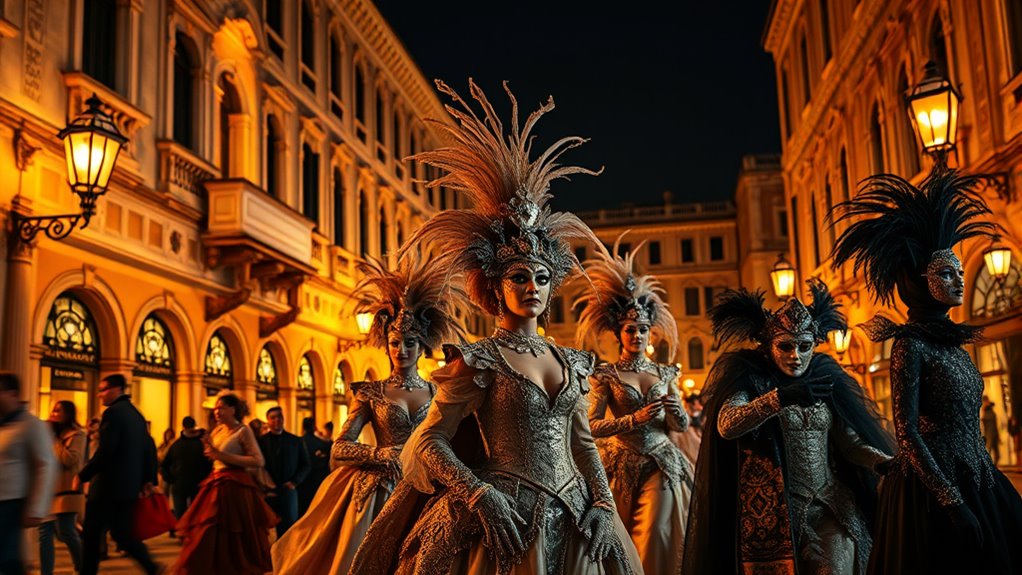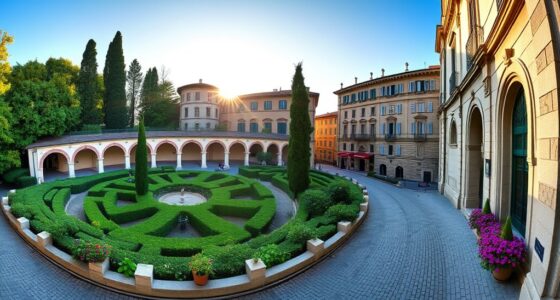Venice’s Carnevale has origins in medieval times when masked balls and festivities allowed people to hide social status and express themselves freely. Over the centuries, masks and costumes became more elaborate, symbolizing mystery and social equality. Today, the festival still celebrates creativity, unity, and cultural heritage through grand parades, masked balls, and artistry. If you keep exploring, you’ll uncover even more about its fascinating history and vibrant traditions.
Key Takeaways
- Carnevale di Venezia dates back to the Middle Ages, featuring masked balls, parades, and elaborate costumes reflecting social status.
- Masks historically fostered anonymity, allowing social equality and free self-expression among Venetians.
- The festival symbolizes social mobility, community unity, and cultural identity through its vibrant traditions and ornate costumes.
- Key events include masked balls, street performances, and parades through Venice’s historic districts.
- Modern Carnevale blends tradition with contemporary influences, promoting global participation and preserving mask-making craftsmanship.
Origins and Early Celebrations of Venice’s Carnival
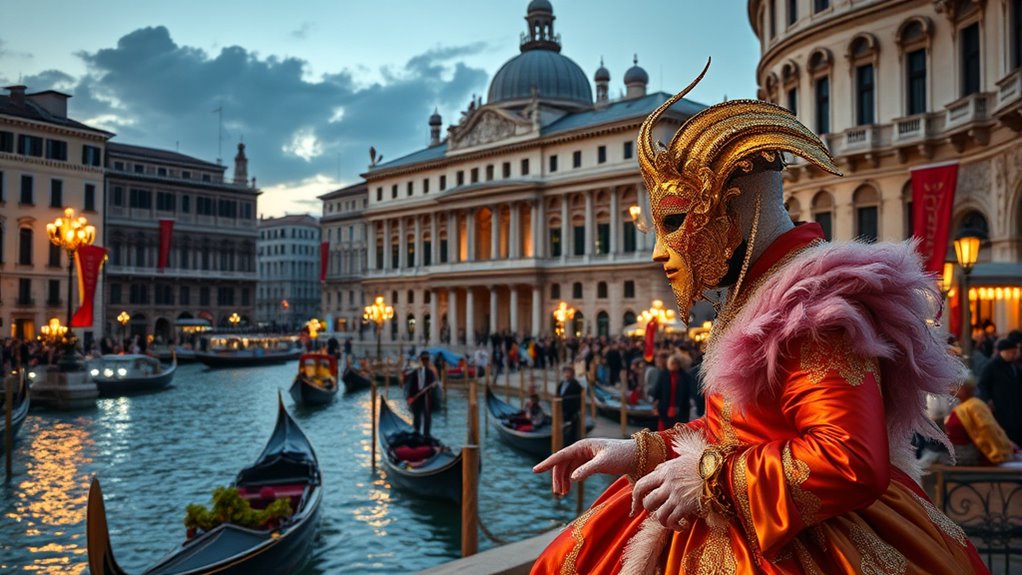
Venice’s Carnival dates back to the Middle Ages, when residents began celebrating with masked balls, parades, and public festivities. During this time, people wore elaborate historical costumes that showcased their social status and creativity. These costumes often featured rich fabrics, intricate embroidery, and luxurious accessories, all crafted with great artisan craftsmanship. Skilled artisans dedicated themselves to creating unique outfits that transformed ordinary citizens into characters from myth or history. The tradition of dressing in such detailed costumes allowed Venetians to indulge in anonymity, fostering a sense of freedom and equality among participants. This early celebration set the foundation for the vibrant, ornate Carnival we see today, emphasizing craftsmanship and historical inspiration that continues to define Venice’s festive spirit. Additionally, the use of luxurious accessories played a key role in highlighting social distinctions and artistic expression during the festivities. The historical costumes and accessories often reflected the influence of artisan craftsmanship, which remains a core element of the Carnival’s enduring allure. The rich fabrics used in costumes also demonstrated the importance of material quality and regional trade connections during that era. Moreover, the tradition of creating elaborate masks contributed significantly to the mystique and allure of Venice’s Carnival, fostering an environment where art and celebration intertwined seamlessly.
Evolution of Masks and Costumes Through the Ages
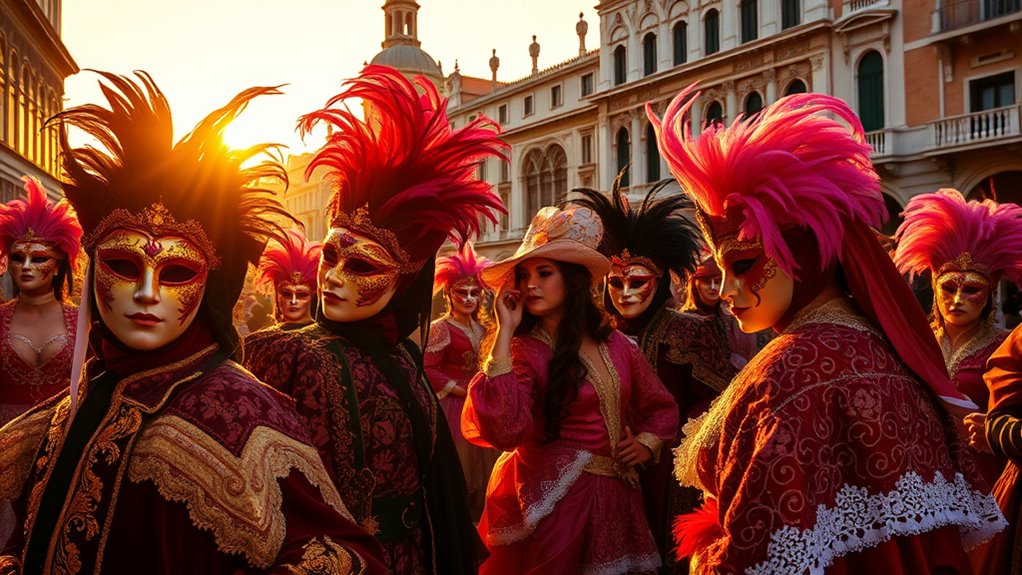
As the tradition of elaborate costumes took root during Venice’s early celebrations, the focus on masks grew even more prominent. Over time, mask craftsmanship advanced, blending artistry with secrecy, allowing wearers to transcend social boundaries. Initially, masks were simple and functional, but as the festival evolved, they became intricate works of art. The design of costumes also transformed, moving from modest attire to lavish ensembles that reflected individual creativity and social status. Maskmakers developed techniques, such as gilding and feathering, to enhance visual impact. This evolution in mask design and craftsmanship helped foster a sense of mystery and freedom, empowering wearers to express themselves beyond societal constraints. Today, this rich history continues to influence the vibrant, diverse costumes seen during Carnevale di Venezia.
Cultural and Social Significance of Carnevale
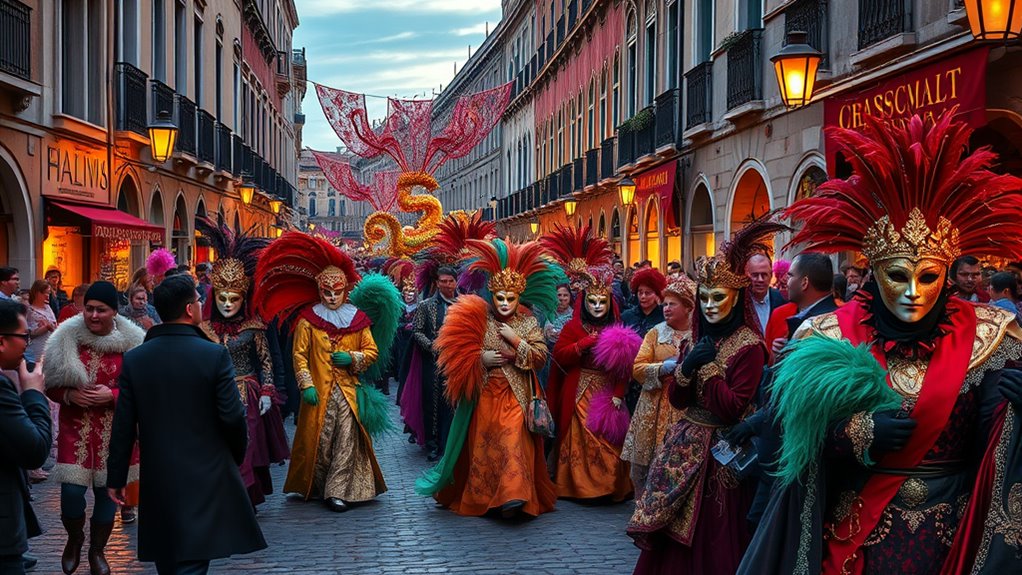
Carnevale di Venezia holds a deep cultural and social significance that goes beyond its colorful costumes and elaborate masks. You experience how masquerade balls create a space where social hierarchies blur, allowing people from different classes to mingle anonymously. During the festival, masks serve as equalizers, giving everyone the freedom to express themselves beyond societal constraints. This tradition fosters a sense of community and shared celebration, breaking down barriers that typically divide Venetians. It’s not just about fun; it’s a powerful reminder of Venice’s history of social mobility and the desire for freedom of expression. Through these masked gatherings, you see how Carnevale sustains its role as a symbol of unity, cultural identity, and social cohesion within Venetian society. Additionally, the use of AI-driven content analysis in documenting and promoting Carnevale helps preserve and amplify its significance for future generations. The festival also encourages the preservation of traditional costumes and masks, which are vital to maintaining its authentic cultural essence. Moreover, ongoing efforts to restore historical costumes ensure that the festival’s visual splendor remains authentic and meaningful. These initiatives highlight the importance of cultural preservation in sustaining Venice’s unique heritage.
Key Events and Traditions During the Festival
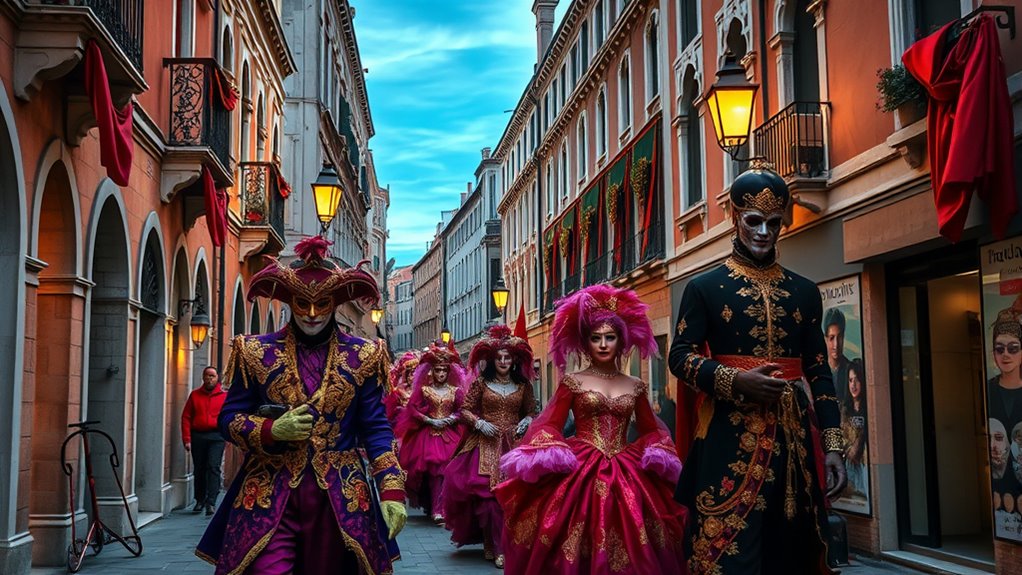
During Carnevale, the city transforms into a vibrant spectacle of events and traditions that captivate both locals and visitors. You’ll witness elaborate mask designs, from intricate lace to bold, colorful creations, symbolizing mystery and elegance. The highlight is the grand parade, with parade routes weaving through the city’s historic streets. Spectators gather along these routes to watch masked performers, floats, and musicians bring the celebration to life. Key events include masked ball nights and street performances, where everyone joins in the revelry. The table below summarizes some main elements:
| Key Event | Description | Location |
|---|---|---|
| Mask Design Competition | Showcases creative masks | Piazza San Marco |
| Parade Route | Main procession through Venice | Rialto to San Marco |
| Street Performances | Live acts and musicians | Throughout the city |
Additionally, the costumes and traditional attire worn during Carnevale add to the festival’s enchanting atmosphere, reflecting Venice’s rich cultural history.
Modern Revival and Global Influence of the Carnival
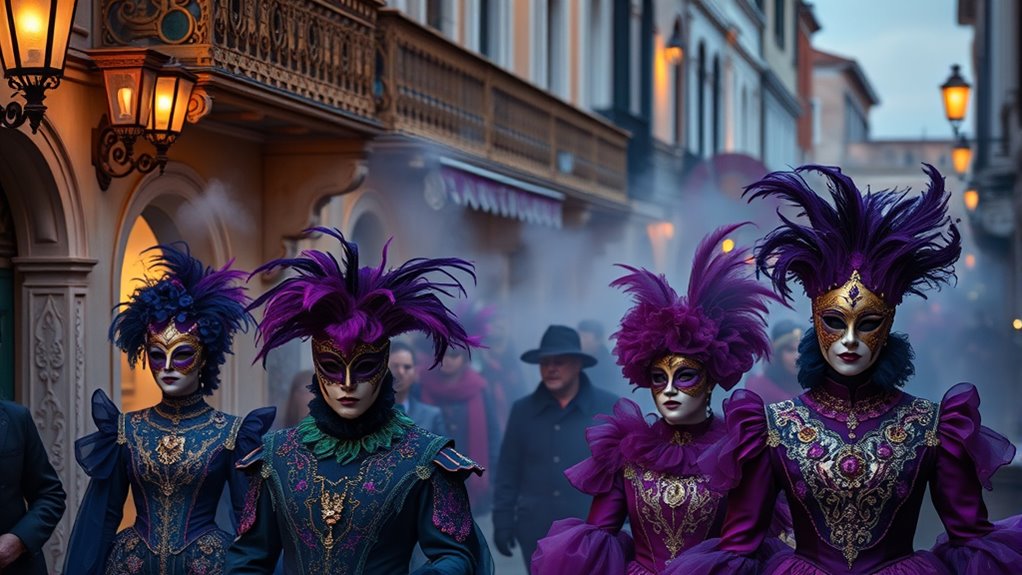
In recent years, the tradition of Carnevale di Venezia has experienced a vibrant revival, blending historic customs with modern influences. This resurgence has attracted international participation, turning the carnival into a global celebration. Artists and craftsmen from around the world now showcase their skills in mask craftsmanship, elevating the artistry behind each mask. Workshops and exhibitions draw visitors keen to learn about traditional techniques, ensuring the craft’s preservation. Modern technology and social media help spread the festival’s allure beyond Venice, inspiring costume designers and performers worldwide. As a result, Carnevale di Venezia has become a symbol of cultural exchange, blending centuries-old traditions with contemporary creativity. The integration of traditional craftsmanship with modern design has further enriched the festival’s cultural significance. This dynamic evolution keeps the spirit of the carnival alive, enthralling audiences both locally and globally. Moreover, the incorporation of modern technology has allowed virtual participation, making the event accessible to a broader audience. Additionally, the preservation of historic customs ensures that future generations can continue to appreciate the festival’s rich heritage.
Frequently Asked Questions
How Did Venice’S Geography Influence the Development of Its Carnival?
Venice’s unique geography, with its canals and island layout, shaped its carnival by making canal transportation essential for moving around and gathering. The island isolation allowed Venetians to create a secretive and playful atmosphere, encouraging disguise and disguise. This separation from mainland influences fostered a sense of freedom, where elaborate costumes and masked celebrations thrived, making the carnival a distinct and vibrant tradition rooted in Venice’s geography.
What Are Some Lesser-Known Traditional Foods Associated With Carnevale?
During Carnevale, you might discover lesser-known traditional Venetian desserts and regional carnival specialties beyond the well-known treats. These include fritole, sweet fried pastries filled with raisins or candied fruit, and crostoli, crispy, powdered sugar-coated pastries. You’ll also find galani, delicate fried strips dusted with powdered sugar, and tortelli, small filled pasta often enjoyed during festivities. These authentic foods add a unique flavor to the vibrant celebration, showcasing Venice’s rich culinary heritage.
How Do Local Venetians Celebrate Carnevale Compared to Tourists?
Imagine stepping into a grand theater where locals are the stars, performing age-old traditions quietly passed down. During Carnevale, Venetians celebrate with secret mask revealing, neighborhood parades, and intimate gatherings that tourists rarely see. While tourists enjoy lively events and grand costumes, locals cherish their traditions, exchanging subtle gestures and stories. Your experience shifts from mere observation to becoming part of a living, breathing Venetian tradition.
Are There Specific Legends or Myths Tied to Venice’S Carnival Origins?
You might wonder about the mythical origins behind Venice’s carnival, where legendary figures and stories blend into the festivities. Some believe the carnival celebrates ancient traditions of disguise and anonymity, linked to mythic figures like the Roman god Bacchus. Others say it honors Venice’s legendary history of resilience and rebirth. These myths add a magical layer to the celebration, making it more than just a festival but a connection to Venice’s enchanting past.
What Impact Has Technology Had on Modern Carnevale Celebrations?
Oh, how technology has transformed Carnevale di Venezia from mysterious masked revelry to a social media spectacle! You now share your costumes online, chasing likes and filters instead of authentic tradition. Digital transformation allows instant global access, but it also dilutes the mystique. Social media amplifies the celebration, yet risks turning Venice’s historic masks into fleeting viral trends. So, you participate more loudly, but perhaps less genuinely.
Conclusion
As you immerse yourself in Venice’s Carnevale, you’re stepping into a world that’s more magical than any fairy tale, more mysterious than the deepest ocean. This festival isn’t just a celebration; it’s a timeless portal to history, culture, and secrets whispered through masks and costumes. Embrace it fully, because within these fleeting days, you’re part of something grander—an everlasting echo of Venice’s soul that will resonate with you long after the masks come off.
